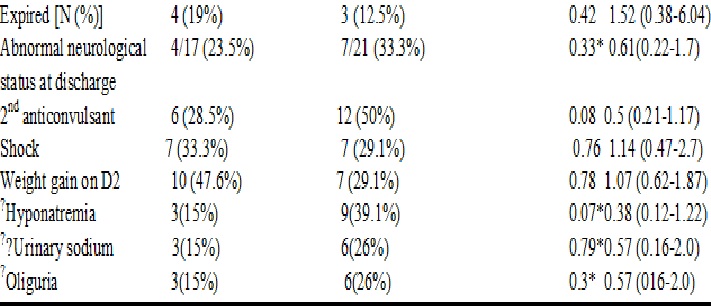Fluid restriction in term neonates with moderate to severe perinatal asphyxia: A randomised controlled trial
Abstract
Introduction: Management of newborns who suffer perinatal asphyxia is primarily based on supportive management, of which fluid and electrolyte management plays a very important role. We studied the role of restriction of fluids in the first 72 h in term neonates suffering from moderate to severe perinatal asphyxia.
Methods: Term newborns with moderate to severe perinatal asphyxia were randomised to receive full or restricted fluids (25 newborns each) during the first 72 h of life. The primary outcome measures were mortality and neurological status at discharge.
Results: Mortality among the full (FF) and restricted fluid (RF) groups was not significantly different, 4 in the FF group and 3 in the RF group with a relative risk (RR) of 1.52 [confidence interval (CI) 0.38-6.04]. The neurological status at discharge was also comparable in both the groups with RR (CI) 0.61 (0.22-1.7).
Conclusion: Routine restriction of fluids in term neonates with moderate to severe perinatal asphyxia does not have any advantage.
Downloads
References
2. UNICEF. Neonatal Health. Available from: https:// www. unicef.in/ Accessed September 19, 2018
3. Lawn JE, Cousens S, Zupan J; et al. 4 million neonatal deaths: when? Where? Why? Lancet. 2005 Mar5-11;365(9462):891-900.doi:10.1016/S0140-6736 (05) 71048-5
4. Mmbaga BT, Lie RT, Olomi R, et al. Cause-specific neonatal mortality in a neonatal care unit in Northern Tanzania: a registry basedcohort study. BMC Pediatr. 2012 Aug 7;12:116. doi: 10.1186/1471-2431-12-116.
5. Levene MI. Management of the asphyxiated full term infant. Arch Dis Child. 1993 May;68(5 Spec No):612-6.
6. Yu PL, Jin LM, Seaman H, et al. Fluid therapy of acute brain edema in children. Pediatr Neurol. 2000 Apr; 22(4):298-301.
7. Kecskes Z, Healy G, Jensen A. Fluid restriction for term infants with hypoxic-ischaemic encephalopathy following perinatal asphyxia. Cochrane Database Syst Rev. 2005 Jul 20;(3):CD004337. doi:10.1002/ 14651 858. CD004337.pub2
8. McGuire W. Perinatal asphyxia. BMJ Clin Evid. 2007 Nov 7;2007. pii: 0320.
9. The Apgar score. Committee opinion No 644. American College of Obstetrician and Gynaecologists. Obstet Gynaecol 2015;126e:52-55.
10. Cornette L, Levene MI. The asphyxiated newborn infant. In: Chervenak FA, Levene MI, editors. Fetal and neonatal neurology and neurosurgery. 4th ed. Edinburgh: Churchil Livingstone; 2008. p542-587.
11. Subramanian S, Agarwal R, Deorari AK, et al. Acute renal failure in neonates. Indian J Pediatr. 2008 Apr;75 (4):385-91. doi: 10.1007/s12098-008-0043-4.
12. Hansens AR, Soul JS. Perinatal asphyxia and hypoxemic ischaemic encephalopathy. In: Clohery JP, Eichenwald EC, Hansen AR, Stark AR, editors. Manual of neonatal care. 7th ed. Philadelphia: Lippincott Williams & Wilkins; 2012. p. 711-728
13. Rainaldi MA, Perlman JM. Pathophysiology of Birth Asphyxia. Clin Perinatol. 2016 Sep;43(3):409-22. doi: 10.1016/j.clp.2016.04.002.
14. Levene MI, Vries LS. The central nervous system: Hypoxic ischaemic encephalopathy. In: Martin RJ, Fanaroff AA, Walsh CM, editors. Neonatal-perinatal medicine: diseases of fetus and infant. 9th ed. Volume 2. Missouri: Elsevier Mosby; 2011. p 952-976.
15. Wintermark P. Current controversies in newer therapies to treat birth asphyxia. Int J Pediatr. 2011; 2011: 848413. doi: 10.1155/2011/848413. Epub 2011 Nov 17.
16. Gunes T, Ozturk MA, Koklu E, et al. Effect of allopurinol supplementation on nitric oxide levels in asphyxiated newborns. Pediatr Neurol. 2007 Jan;36 (1):17-24.doi:10.1016/j.pediatrneurol. 2006.08.005
17. Levene MI, Gibson NA, Fenton AC, et al. The use of a calcium-channel blocker, nicardipine, for severely asphyxiated newborn infants. Dev Med Child Neurol. 1990 Jul; 32(7):567-74.
18. Gluckman PD, Wyatt JS, Azzopardi D, et al. Selective head cooling with mild systemic hypothermia after neonatal encephalopathy: multicentre randomised trial. Lancet. 2005 Feb 19-25;365(9460):663-70. doi:10. 1016/S0140-6736(05)17946-X
19. Shankaran S, Laptook AR, Ehrenkranz RA, et al. Whole-body hypothermia for neonates with hypoxic-ischemic encephalopathy. N Engl J Med. 2005 Oct 13; 353 (15):1574-84. doi:10.1056/NEJMcps050929
20. Whitelaw A. Systematic review of therapy after hypoxic ischaemic brain injury in the perinatal period. Semin Neonatol. 2000; 5: 3-40.
21. Agarwal R, Jain A, Deorari AK, Paul VK. Post-resuscitation management of asphyxiated neonates. Indian J Pediatr. 2008 Feb;75(2):175-80.
22. Gopal G. Acute Kidney injury in perinatal asphyxia. Indian J Pharma Biological Research. 2014; 2: 60-65.
23. Nouri S, Mahdhaoui N, Beizig S, et al. [Acute renal failure in full term neonates with perinatal asphyxia. Prospective study of 87 cases]. Arch Pediatr. 2008 Mar;15(3):229-35. doi: 10.1016/j.arcped.2008.01.011. Epub2008 Mar 7.

Copyright (c) 2018 Author (s). Published by Siddharth Health Research and Social Welfare Society

This work is licensed under a Creative Commons Attribution 4.0 International License.


 OAI - Open Archives Initiative
OAI - Open Archives Initiative


